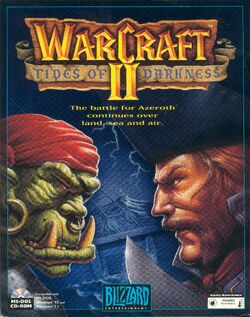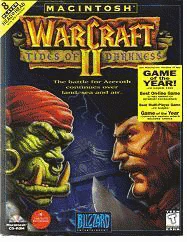| Warcraft II: Tides of Darkness | |
|---|---|
 Cover art for Warcraft II | |
| Developer(s) | Blizzard Entertainment |
| Publisher(s) |
PC, Mac OS US: Blizzard Entertainment EU - Ubisoft Saturn, PlayStation US, EU - Electronic Arts JP: Electronic Arts Victor |
| Platforms | MS-DOS, Mac OS, Sega Saturn, PlayStation, Microsoft Windows |
| Release |
PC, Mac OS US - 9 December 1995 EU - 1996 Saturn, PlayStation US, EU - 31 August 1997 JP - 27 November 1997 |
| Latest release |
Original - 1.4 Battle.net Edition - 2.02 |
| Genre(s) | Real-time strategy |
- For the expansion RTS game, see Warcraft II: Beyond the Dark Portal.
Warcraft II: Tides of Darkness is the second, highly popular real time strategy game from Blizzard Entertainment, set in the Warcraft Universe.
Warcraft II: Tides of Darkness (usually simply called Warcraft II; sometimes abbreviated to WCII, WC2 or War2) is a sequel to the popular real-time strategy game Warcraft: Orcs & Humans, published by Blizzard in December 1995. Users play either Orcs or Humans in a fantasy medieval world full of magic and swords. It was originally written for the DOS operating system, though it had a MS Windows launch screen and played well under Windows 95. In addition, there was a Macintosh version of the game. Blizzard also released an expansion pack for Warcraft II: Tides of Darkness known as Warcraft II: Beyond the Dark Portal. Blizzard made a new version of Warcraft II in 1999, called Warcraft II: Battle.net Edition. Changes made for this release included porting the game's code to Microsoft Windows, fixing a few minor bugs, and enabling multiplayer support via Blizzard's online matchmaking service, Battle.net.
The novel Tides of Darkness, by Aaron Rosenberg, focuses on the events in this game.
Warcraft II Users may play each other online (via LAN or the Internet) using existing maps or ones they create. Users may also play the game solo, taking them through a story in which orcs and humans are at war.
Characters in the game, as in most Blizzard games, will say different things on being clicked repeatedly (clicking on a sheep long enough will cause it to blow up, yet another exploding sheep reference).
Taken from the Wikipedia Article
Units
See Warcraft II Units.
Structures
Utilities, modifications and conversions
Warcraft II was an unusual game for the time because a large number of third-party utilities were written for it. Among the first things, Daniel Lemberg reverse-engineered the Warcraft II map file (*.pud) format and created the first third-party map editor, War2xEd, which could do numerous things the bundled map editor could not do, such as editing unit attributes. Although Daniel Lemberg did not make the source code for War2xEd public, he did publish the complete Warcraft II map file format, which led to a wealth of new tools. More importantly, Blizzard began to use War2xEd internally, and it influenced them to bundle a feature-rich editor with their immensely popular game StarCraft.
The next important breakthrough came when Alexander Cech and Daniel Lemberg broke the encryption used in the base game data files. Alexander Cech went on to create a program called Wardraft, which allowed users to browse and modify the contents of the game data files, allowing comprehensive modifications. The spawn of extensive alterations became known as "Total Conversions", and a great many projects were in motion for a good long while. Some of the more prominent were "DeathCraft: Twilight of Demons" by Dirk "The Guardian" Richartz, "War of the Ring" by Gurthaur, "Editor's Total Conversion" by Fronzel Neekburn and the whole of the Warclan, and the noteworthy "Rituals of Rebirth" spearheaded by Kalindor, Kosmous, and Commoner.
There was also a free software game inspired by Warcraft II called Freecraft, which, while allowing users to import actual game data from Warcraft II, also contained their own artwork and scenarios. Although it used no art or code from Warcraft II, the project received a threatening cease-and-desist letter from Blizzard, apparently due to similarity to the Warcraft trademarks. Not willing to fight Blizzard, the maintainers cancelled the whole project. The project was later rekindled under name Stratagus.
Many of the utilities and conversions have faded into the depths of obscurity, but the appeal of feature-rich editors and total conversions has lived on.
Quotations
One of the features of Warcraft II are the unit quotes. If a single unit was clicked several times in a row, the unit's voice samples would change. The unit would start getting angry at the player, or start saying silly things in reference to movies, games, or other things. For example, a footman might say, "Don't you have a kingdom to run?". Footmen and Grunts said different things in the game's demo, from some of those they did in the retail version, most of them exhortations to buy the latter.
Warcraft II: Battle.net Edition
Warcraft II Battle.net Edition logo
Warcraft II: Battle.net Edition is an Battle.net-enabled version of Warcraft II: Tides of Darkness, with the expansion Warcraft II: Beyond the Dark Portal built in. The original version of Warcraft II supported online play, but only through IPX protocol, and not the TCP/IP protocol which became standard after it's release. Many players used the paid-for program Kali, which emulated an IPX network over the internet, and allowed people to play it easily online. Wacraft II: Battle.net Edition added support for Battle.net. This is essentially the same as Warcraft II, but it allows for usage on Battle.net, and, unlike its offline counterparts, does require a CD Key to install. The original title for the game was "Warcraft II: Platinum Edition" before release, until it was changed to the title it has now.
The game features many upgrades and enchancements over the original version. Features from StarCraft, such as right-click commands for units, and queueing multiple units for production, were implemented. The game was also ported to be natively supported under Windows, unlike the original game which ran under DOS. A fix for newer processors was included so reguardess of how fast your processor was, the screen scroll speed was consistent. Unlike the original version which was meant to be run on a 486 processor and running on a modern processor the screen scroll speed was too fast.
Other upgrades and enchancements over the original game include:
- Ability for up to eight players to compete over Battle.net using "Spawning" technology from one CD.
- Automatic map passing over Battle.net.
- Implementation of Top vs. Bottom multi-player template.
- Shared Vision in multi-player games.
- Improved game set-up, game options, dropping of players and inclusion of Battle.net chat
- Game speed is set prior to a Battle.net game beginning, and cannot be changed.
- Incorporation of the 3 Pauses per player/per game rule.
- Assigning and selection of Groups through # keys.
- Ability to choose Random starting race, resources and tileset.
- Attack Move command will now function correctly
- Patrol command now sends units to the selected location rather than stopping after any contact
- Set maps and game parameters for Ladder Games
- Ctrl+click or double-click will select closest 9 units of that type currently on the screen.
- Space bar centers the map on last 8 transmissions (sequential.)
- Current food displayed along with gold/oil/lumber
- Maintained compatibility with the DOS version of Warcraft II via local area network or modem.
- Unit limit raised from 600 to 1200 for Enhanced games.
- Upper limit of 200 food for each player, like StarCraft.
- Mining out an oil rig completely no longer returns a small amount of lumber and gold to the player.
- Flying Machines, Goblin Zeppelins, Goblin Sappers, Dwarven Demolition Teams now have a Patrol option.
- Canceling Foundries no longer uses all of the oil you spent to build it.
- Allies can see friendly invisible units now.
- Allies' towers and flying units now reveal enemy subs.
- Partially-built towers can no longer see submarines.
- Death Coil will no longer damage allies.
- New sounds have been added for Skeletons, Runes, Eye of Killrogg, and for completed upgrades.
- First Town Hall/Great Hall now build at the speed of a Farm. All other Town Halls/Great Halls build at the normal rate.
- You can now take 1000 screenshots instead of just 100.
- Support for two new game speeds (Slowest and Faster.)
From the Blizzard Site
With the death of the Orcish Warchief Blackhand, his underling Orgrim Doomhammer was quick to seize control over the most powerful of the Orcish forces on Azeroth. Although each day finds other factions growing stronger within the chaotic Horde, it seems certain that all of the clans will follow Orgrim's plans to hunt down and destroy the renegade Azerothiens wherever they choose to run...
Sir Lothar, in charge of the scattered armies of Azeroth since the death of King Llane, has led his people across the Great Sea to the shores of Lordaeron. By enlisting the armies of Lordaeron, and making new allies in the Elves and Dwarves, a mighty force known as the Alliance has been forged. Now, the last of the once great armies of Azeroth seek retribution for the loss of their homeland.
Cheat codes
Trivia
- After the first Warcraft and when we were talking about Warcraft II, there was an idea for about a week where we'd open another portal open and have the Orcs invade the modern-day world. We had this whole cut-scene we were talking about where it was going to be dragons and F-16s and firefights and stuff. And we were like, "Man, that's going to be weird. That's going to suck. That's not going to be Warcraft. - Bill Roper, Games for Windows, Jan, 2007.
See also
- The full Warcraft II: Tides of Darkness manual here at WoWWiki
- The History of Orcish Ascension - Lore prior to Warcraft II as written by Gul'dan
- A Brief History of the Fall of Azeroth - Lore prior to Warcraft II as written by Aegwynn
- Aftermath of the Second War - Official tale of Warcraft II events (Author unknown)
- Tides of Darkness missions
- Quotes of Warcraft II
- Official Warcraft II Battle.net edition site
- MobyGames entry on Warcraft II
- Warcraft II for Linux
- Warcraft II Occult fan site
Known information and speculation
This article or section includes speculation, observations or opinions possibly supported by lore or by Blizzard officials. It should not be taken as representing official lore.
|
- In the Human Campaign of Warcraft: Tides of Darkness, the Humans eventually win the Second War. In the Orc Campaign, the Orcs eventually win the Second War. Warcraft II: Beyond the Dark Portal follows as if the Human Campaign is the true outcome.
- Many of the Horde missions became accepted lore, while other missions were left out of accepted lore to allow for an Alliance victory.
| |||||||||||||||||||||||||||||||||||||||||||||||||||||||

